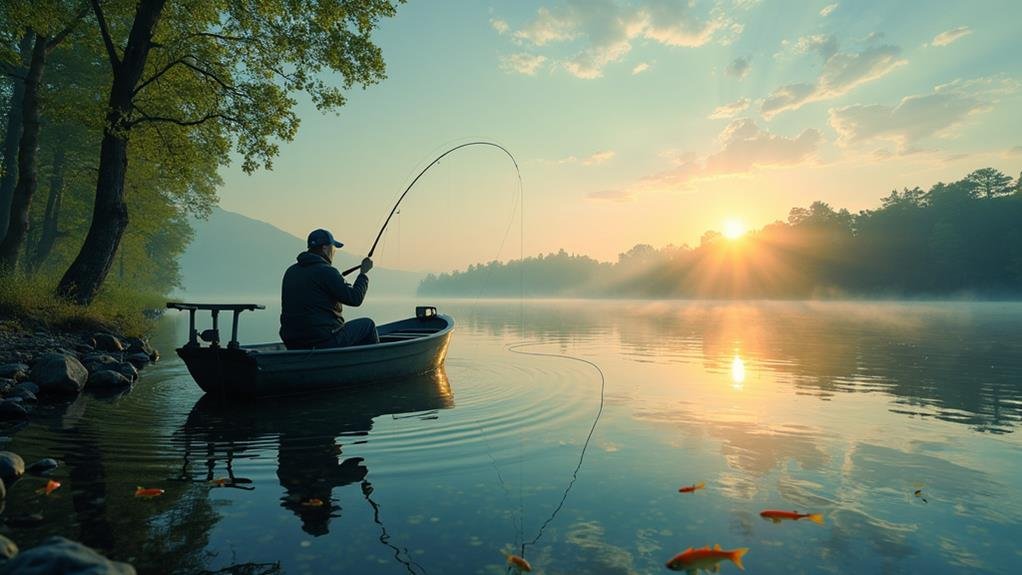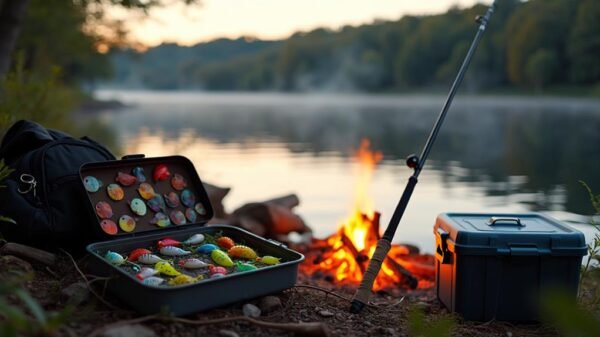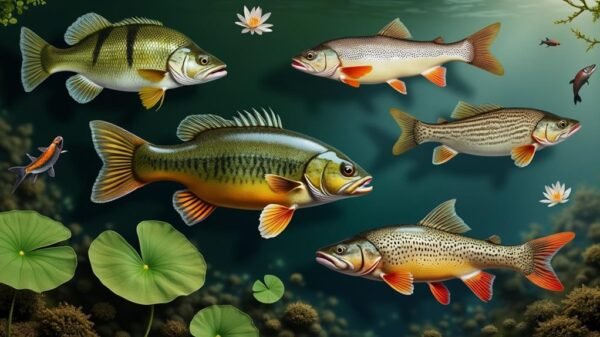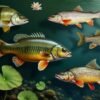If you're starting your expedition into freshwater fishing, you're in for an exciting escapade! Freshwater ecosystems, like rivers and lakes, host amazing fish species. You might catch a Largemouth Bass, known for its strength, or perhaps a colorful Bluegill from the sunfish family. Each species has unique features, like the forked tail of a trout or the whiskered barbels of a catfish. Pay attention to their habitat preferences; some love rocky areas while others thrive in murky waters. With the right gear and techniques, you're set for success. Stick around to discover more about these fascinating fish and how to catch them!
Understanding Freshwater Ecosystems
Freshwater ecosystems, such as rivers, lakes, and wetlands, are crucial for our planet. These habitats support a variety of life forms, including amphibians, birds, and fish. Recognizing the importance of these environments enhances appreciation for the wildlife they nurture. Different fishing techniques, like fly fishing and baitcasting, can elevate your outdoor experience while respecting the natural balance, making it essential to understand the significance of structures for freshwater angling.
These ecosystems are more than just scenic landscapes; they are complex systems that depend on clean water, nutrient cycling, and robust plant communities. If you wish to explore or contribute to the conservation of these areas, comprehending their structure and function is vital. For instance, riparian vegetation stabilizes banks and provides food and shelter for aquatic life.
When engaging with freshwater ecosystems, remember that your actions can have lasting impacts. Simple practices, like reducing plastic waste and respecting wildlife habitats, can lead to meaningful improvements. So, whether you are casting a line with a Shimano reel, hiking with Merrell boots, or simply enjoying the outdoors, be mindful of the delicate balance within these ecosystems. By understanding and caring for these environments, you contribute to their resilience for future generations. Embrace the adventure of exploration while protecting these invaluable resources.
Common Freshwater Fish Species

Many anglers and nature enthusiasts appreciate the diversity of common freshwater fish species found in various ecosystems. From lakes to rivers and ponds, these fish provide numerous opportunities for exploration and enjoyment. One of the most sought-after species is the Largemouth Bass, known for its spirited resistance and popularity among both novice and experienced anglers. This species is abundant in North American waters, making it a primary target for freshwater fishing.
Another notable species is the Catfish, recognized for its distinctive whisker-like barbels and bottom-dwelling habits. Catfish are often pursued for their size and unique flavor, making them a staple catch for many anglers. If you're in search of something colorful, the Sunfish family, including Bluegill, offers vibrant hues and is a joy to catch, appealing to both fishing enthusiasts and nature observers.
Trout, particularly Rainbow and Brook Trout, are highly regarded by many anglers. Found in cool, clear streams and lakes, they present a thrilling challenge. You'll also find Crappie, a popular choice for family fishing outings, known for their schooling behavior and tasty fillets.
Understanding these common freshwater fish species can enhance your outdoor experience. Whether you're casting a line with a Shakespeare rod or simply enjoying the serene environment, knowing the aquatic inhabitants can deepen your appreciation for nature. So, gather your gear and prepare for an exciting adventure in the great outdoors.
Identifying Key Features

Recognizing key features of common freshwater fish species enhances your fishing experience. When by the water, knowing what to observe increases enjoyment. Begin with body shape; for instance, bass appear sleek and streamlined, whereas catfish exhibit a rounded, bulky form. Largemouth bass, regarded as premier freshwater game fish, rank among the most prevalent aquatic species, making them a primary target for anglers.
Next, focus on colors and patterns. Many fish, like bluegill, showcase bright, vibrant hues for quick identification. Look for distinct markings, such as horizontal stripes on crappie that differentiate it from other species.
Fins are also important! The number and shape of fins serve as key indicators. For example, trout feature a unique forked tail, while sunfish possess rounder fins.
Habitat Preferences of Freshwater Fish

Understanding freshwater fish habitat preferences enhances catch success. Freshwater fish inhabit varied environments, making location knowledge essential. For instance, some species favor rocky habitats with ample cover, while others thrive in tranquil, slow-moving waters. In Florida, anglers often find largemouth bass near submerged structures like fallen trees or boulders. Conversely, trout typically inhabit cooler, clear streams and rivers with swift currents. If targeting catfish, seek out murky waters, usually near the bottom, where they find food and shelter.
Water temperature and clarity are crucial factors influencing fish behavior. Warmer summer waters may drive fish to deeper zones, while cooler spring and fall temperatures often bring them closer to the surface.
Basic Fishing Techniques for Beginners

Fishing can be an exhilarating adventure, and mastering essential techniques is vital for success. Start by selecting the right equipment. A Shimano spinning rod and reel combo is perfect for beginners since it's easy to use and versatile. Don't forget to choose the appropriate fishing line and hooks based on the fish species you're after, such as bass or trout. Additionally, understanding the various types of freshwater bait, like live worms or artificial lures, can significantly enhance your fishing experience.
Next, get acquainted with bait options. Live bait, such as nightcrawlers or minnows, often proves effective. If you lean towards artificial lures, begin with simple ones like Mepps spinners or Zoom soft plastics. They are straightforward to cast and can attract a variety of fish.
Mastering your casting technique is essential. Practice casting in a safe area before heading to the lake or river. Target spots where fish may hide, such as near rocks, aquatic plants, or submerged logs. Always remember that fishing requires patience; it takes time and dedication.
When you feel a tug on your line, don't rush! Pause for a moment before reeling in to ensure the fish is firmly hooked. Lastly, familiarize yourself with local fishing regulations and conservation methods. Caring for the environment not only protects fish populations but also enhances your overall fishing experience. With these techniques, you're on your way to enjoying the freedom and excitement that fishing offers.



























